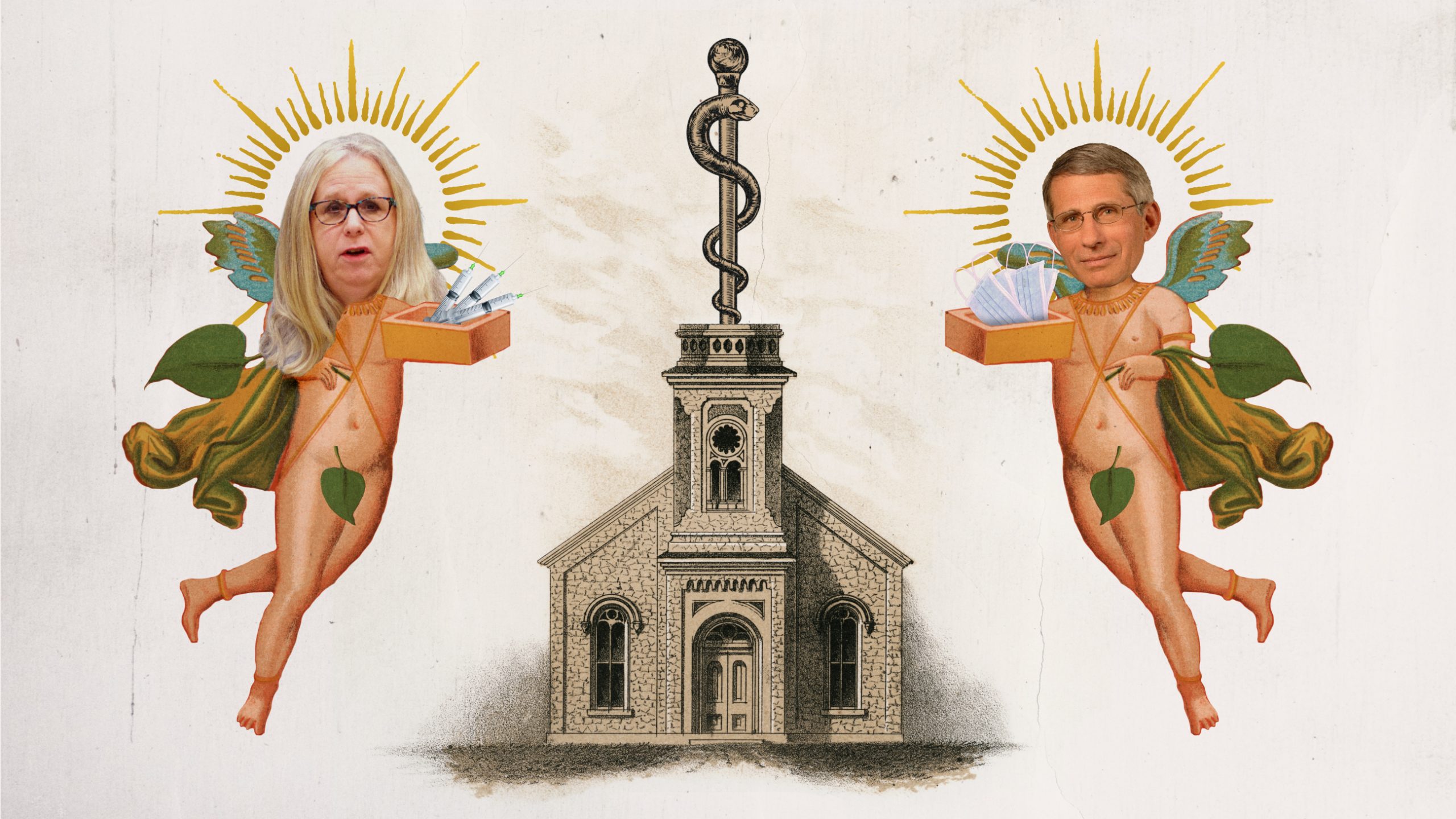The Zombie Enlightenment enslaves us to a new religion.
Sex is Real

Human bodies are irrevocably either male or female. Attempts to change that are recklessly destructive.
The human body is not a machine to be toyed with, and biological sex is not an accidental feature, like hair length or nail color, to be stripped away or altered at will. Our physical identity as male or female affects every aspect of our health and biological development. Therefore tampering with biological sex, as trans extremists regularly do, has devastatingly harmful consequences. These interventions are particularly frightful—and reprehensible—in the case of children.
One of the biggest lies of the trans rights ideologues is that chromosomal karyotype—the shape and number of chromosomes—determines your sex. This is to support the larger claim that, because there is more diversity in sex karyotype (the 23rd chromosomal pair) than XX and XY, there are therefore more than two sexes.
It begins with a kernel of truth. Although most females have the XX karyotype, and most males have the XY karyotype, many individuals have karyotype variances, sometimes resulting in developmental and reproductive disabilities. But this very fact undermines the trans extremists’ effort to identify sex with karyotype. Basic genetics stipulates that it is not chromosomes, but the genes which the chromosomes carry, that determine a surface traits such as hair color. This expression of chromosomal patterning in macro-level physical traits is called the phenotype.
“Male” and “female” are in fact phenotypes. They are whole-body, developmental plans, trajectories, and histories. In humans, there are only two sex phenotypes, because reproductive sex is a strict binary. Males and females produce different gametes, i.e., special cells designed to meet in reproduction. We have pictures of the two gamete types, the sperm and the ovum. We know what they do.
Karyotype diversity within each sex is just that: chromosomal variation within categories, not a superabundance of other categories. Many women have many different karyotypes; they are all still women. Many men have many different karyotypes; this does not make them anything other than men. Sex is defined with explicit reference to having the reproductive structures in place to produce either gamete. In females, our eggs begin dividing when we are still in the womb (Meiosis 1), and then divide again (Meiosis 2) at adolescence, once a month. A consequence of this is that your grandmother’s pregnancy stress affected you, because half of you was an egg in your mother when she was in her mother’s womb.
Males, meanwhile, do not produce gametes until adolescence, at which point they create them on a continuous basis. From before birth, we are on fundamentally different paths, and the twain shall only meet during reproduction. Women with reproductive disabilities do not become men: morphologically and developmentally, they are still following the female path. This matters because women have many different health symptoms and risks than men.
In humans, two factors determine whether you develop as a male or as a female: 1) men have the sex-determining region Y gene, which is located on the Y chromosome. The Y gene is not the same thing as the Y chromosome, which also carries at least 60 other genes. 2) Men have a high genetic capacity to produce testosterone.
Absent either of these factors, the individual will develop as a female. That is: in humans, female is the default. So, for instance, individuals with androgen-insensitivity syndrome are not sensitive to the anabolic steroid testosterone, and do not metabolically respond on a cellular level. They will develop as a female, despite having an XY karyotype. An individual with XO karyotype, where one chromosome in the 23rd pair is deleted, will also develop as a female. As for individuals with XXY, (assuming no deletion or mutation of the sex-determining region Y (SRY) gene on the Y chromosome), in those for whom the SRY gene does activate and cells can respond, the fetus will develop as a male with a genetic and developmental disorder.
Not one of these is a third sex. A third sex would require an additional, functional body plan that produced a third kind of gamete that had some role in the human reproductive process. No such third plan exists. Deviations in and variations on the first two plans are not evidence of a third plan, any more than misspelling a word makes it a hieroglyph.
Arrested Development
Devotees of radical gender theory are fundamentally ignorant of basic scientific facts about genetics—much as flat-earth advocates predictably have a minimal understanding of physics. So it is no surprise that they are equally ignorant about the possible ramifications of attempting to use powerful drugs to suppress normal development in adolescents. Adolescents cannot possibly consent to such treatment, which is clearly likely not to be in their best interests. I am referring to so-called “puberty blockers.”
These drugs are advertised by trans rights activists as some sort of fountain of youth that allows you to press pause—with no negative consequences—on the sex-hormone brain and body development that is supposed to happen in adolescence. A recent article in the New York Times described a young girl, now known as Sebastian Liafsha, as having “paused the development of unwanted secondary sexual characteristics like breasts and a menstrual cycle” using puberty blockers. This is the typical trans narrative about blockers: they let children delay puberty until they are ready to switch genders.
But even the trans radicals’ own propaganda says otherwise. The show “I am Jazz” documents the tragic story of Jazz Jennings, a male child who has been puberty-suppressed since he was 11. One consequence for him is genital underdevelopment that meant, when it came time to undergo his first of several “gender-affirming” “bottom surgeries,” his doctors had to take a portion of his stomach lining in order to have sufficient tissue to use to create a pseudovagina, or “neovagina” as the medical field calls it.
I will restrict myself to just one of many possible systems that are profoundly and inescapably damaged by puberty blockers, in direct proportion to dose and length of time on the drugs: bones. It is well known in the medical field, and can be easily verified on PubMed, that sex hormones are critically important for building and maintaining bone density across the lifespan, and especially in adolescence and young adulthood. Bone density peaks at age thirty, after which point bone creation and bone resorption (re-absorption) roughly equal each other, and then eventually, bone resorption begins to exceed bone creation.
At that point, your overall baseline bone density is what determines if and when you get osteoporosis, all else being equal. Women are more likely to develop osteoporosis than men. There are many probable reasons for this, including: overall smaller body size, smaller bones in relation to body size, weaker muscles prompting less bone creation in response to lower mechanical stress, and a significantly longer lifespan. Estrogen is recognized to be a more significant factor than testosterone in the creation and maintenance of optimal bone density in both sexes.
Puberty blockers do many things developmentally. One thing they do is delay the fusion of growth plates. They are sometimes prescribed for that reason: for instance, to allow a child who will have an abnormally short height to grow taller. However, this comes at a significant cost to bone density. It allows the bones to grow longer in the absence of estrogen, which is needed for them to become sufficiently dense. This means fractures later in life.
And “later in life” may be far sooner than one typically thinks of as osteoporosis age. Because of estrogen’s role in bone density, some patients develop fractures in their twenties and thirties. The sum total of all this is that female-to-male transgender people are likely to be far more negatively impacted long-term by puberty blockers, in addition to typically undergoing more aggressive and irreversible medical interventions than trans women.
When I bring this up, trans rights activists will tell me that osteoporotic changes from long-term puberty blockers (taken for aesthetic and psychiatric reasons, we must remember) can be easily managed with medication. These medications, however, are profoundly harmful themselves, and should not be relied on as a backup or a reason to disregard predictable long-term complications.
There are two main classes of drugs that are prescribed to maintain bone density in the context of osteoporosis: sex steroids like estrogen, and biphosphonates. Since the individual is seeking to suppress sex steroids, that avenue is now closed. Bisphosphonates, meanwhile, have many side effects, including causing their own changes in bone density that result in complications like osteonecrosis of the jaw. Osteo, referring to bone, and necrosis, referring to death. This in practice looks as if some portion of the upper or lower jawbone is visibly rotting away inside of the person’s mouth.
There is little that can be done to correct this, besides managing possible infection, as the individual with osteoporosis typically cannot go off of these medications without the complications of osteoporosis accelerating, including fractures.
Religious Violence
This does not address the differential sensitivity to sex hormones of different areas of the brain. If area A is more sensitive to testosterone than area B, and area A does not get sufficient testosterone to grow due to puberty blockers, it will be out of proportion to Area B. If area B relies on area A to be a certain size to function appropriately in adulthood—perhaps Area A produces a needed hormone in proportion to its size—and area B is the normal size, area B will not function well. This could have neurological, psychiatric, or other complications down the road, which will then be blamed on gender dysphoria. Some of these structures involve non-sex hormone production, such as the pituitary and vasopressin, which may have additional health complications.
Transgender ideology is a fundamentalist religious movement that has a specific dogma, specific rituals, rites, and practices. It is currently attacking the concept of comprehensive women’s health education and attempting to impose these religious practices on young people via propagandizing them and the medical field. Trans radicals preach that medically transitioning is the only solution to angsty teenagers’ pain. They do not have a solid scientific foundation, although they make a pretense of it. We are meant to be our children’s stewards and we owe them safety from the consequences of their own foolishness and susceptibility to cultural manipulation.
The American Mind presents a range of perspectives. Views are writers’ own and do not necessarily represent those of The Claremont Institute.
The American Mind is a publication of the Claremont Institute, a non-profit 501(c)(3) organization, dedicated to restoring the principles of the American Founding to their rightful, preeminent authority in our national life. Interested in supporting our work? Gifts to the Claremont Institute are tax-deductible.
Liberal feminism relentlessly aggresses against the female body and soul.
The digital era has awoken an ancient revulsion with the flesh.
Finding a middle ground between Kardashian bod and blobby positivity.




